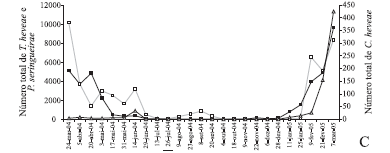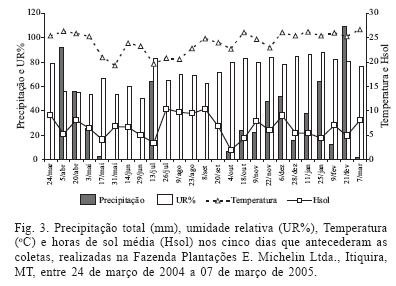The population dynamics of Calacarus heveae Feres, 1992, Phyllocoptruta seringueirae Feres, 1998 (Eriophyidae) and Tenuipalpus heveae Baker, 1945 (Tenuipalpidae) was studied on six rubber tree clones (Hevea brasiliensis Muell. Arg.) in south of Mato Grosso State, Brazil, in order to verify the seasonality and the possible differences on the infestation levels of these mites. The samplings were made from March 2004 to March 2005, with an average interval of fourteen days between each sampling. In each sampling, 100 leaflets were taken from each clone crop, and the total number of mites found in both leaf surfaces was registered. The infestation levels of mites differed among the clones. The clone RRIM 600 showed the highest number of T. heveae, while PB 235 and PB 260 had the highest abundance of P. seringueirae and C. heveae, respectively. On the other hand, this latter clone had the smallest infestation of T. heveae and P. seringueirae, while in PB 235 the lowest population of C. heveae. The critical period of mite infestation was observed in the first semester, although, there was variation in the duration of phytophagous occurrence and the infestation peak on six rubber trees clones studied.
Hevea brasiliensis; infestation; pest mites; seasonality










